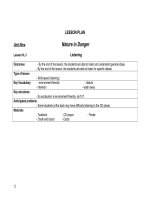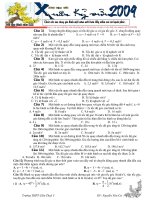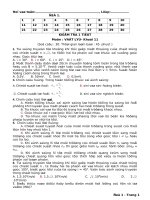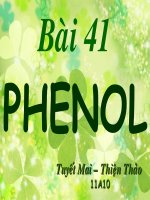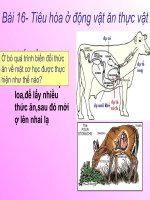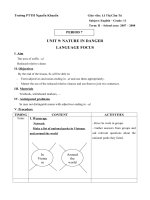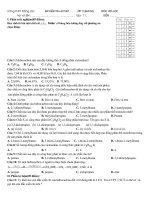10376 11a
Bạn đang xem bản rút gọn của tài liệu. Xem và tải ngay bản đầy đủ của tài liệu tại đây (1.4 MB, 30 trang )
Chapter
11
Agrochemicals
Manfred J. Mirbach and Bassam El AIi
11.1
Introduction and History
11.2 Chemical Pest Control
11.2.1
Herbicides
11.2.2
Insecticides
390
11.2.3
Fungicides
392
11.2.4
Miscellaneous compounds
396
Chemical synthesis of pesticides
401
Formulated Products
11.4
Biological Pest Control
11.5 Testing Requirements for New Pesticides
11.5.1
403
407
410
General information and physical and
chemical properties
410
11.5.2 Toxicity
413
11.5.3
Residues in food
414
11.5.4
Human safety risk assessment
415
11.5.5
Environmental fate and environmental toxicology
417
Social and Economic Aspects
420
11.6.1
Social consequences of pesticide use
420
11.6.2
Economic aspects
Bibliography
11.1
386
11.2.5
11.3
11.6
381
385
422
426
Introduction and History
Global food consumption will double in the next 25 years. The reasons
are the increase of the world population and a higher consumption of
every single person. The area of arable land, however, will remain constant. Consequently, the available agricultural land area per person
Population
Arable Land
Figure 11.1 Change of the world population and area of arable land (population in billion, arable land in relative numbers). (Source: FAO statistics,
available from www.fao.org and www.syngenta.com)
has decreased, for example, from 0.5 ha per person in 1950 to 0.25 ha
per person today. In 2050, only 0.15 ha of arable land will be available
for each person. This illustrates the challenge that agriculture faces. To
feed the growing world population, farms must produce more food on less
land (Fig. 11.1).
This challenge is not new. About 200 years ago the world's population
was about one-quarter of that today and a much larger fraction of these
people worked on farms. Nevertheless, famine, malnutrition, waves of
pests, and diseases were very common in most parts of the world even
though people were practicing agriculture in a similar way as we do
today—seeding, growing, harvesting, and storing. The major difference
was that they used traditional field management.
The oldest system of food gathering is that of the nomads. When their
basic food supply gets exhausted in one place, they migrate to a different area. In other areas, nature helped to keep the land fertile. For
instance, in the Nile valley the river flooded the land nearly every year
and regenerated the agricultural soil to make it ready for a new harvest.
The rotational crop system also has a long tradition. One crop is planted
in the first year, a different one in the second year, and then the land is
left fallow for a few years to regenerate, before it is used again for crop
production.
Mineral fertilizers. It is estimated that traditional farming without chemical and mechanical support can feed approximately 1.5 billion people.
Today Earth has a population of 6 billion. That means something has
happened in between that led to an enhanced productivity in agriculture. The first step to modern field management was the introduction
of mineral fertilizers. Beginning with the 19th century, the world population grew rapidly and a global famine was looming. Therefore, scientists worked hard to find solutions to improve crop yield. The first
important discovery was that the organic carbon in plants comes from
photosynthesis using the carbon dioxide in air and not from organic
matter contained in the soil.
The soil supplies the inorganic minerals and water. Justus Liebig, an
eminent German chemist and teacher, discovered that four elements are
essential for plant growth: nitrogen, phosphorous, calcium, and potassium. Later, additional essential elements (trace elements) were discovered. The growth rate of plants is limited by the component that is
minimum in the accessible soil layer. When one element is in short
supply, adding large quantities of other elements does not increase the
yield. It is like a barrel in which the planks are of uneven height. When
it is filled with water the lowest plank always determines the capacity,
no matter how high the others are (Fig. 11.2).
In Liebig's day, nitrogen was the limiting element in soil. Therefore, he
proposed to use natural nitrogen sources, like Chile saltpeter, guano, and
manure to fertilize the fields and indeed the productivity increased rapidly.
Anew food crisis loomed at the end of the 19th century, when the supplies of Chile saltpeter were nearly exhausted and the little that was left
was reserved for military purposes. The supply of food for the world population was again at risk. Desperately, new sources of nitrogen fertilizers were sought. There is an abundance of nitrogen in the air. However,
plants are unable to use it, because they cannot split N2 molecules.
Discovery of a catalytic reaction, called the Haber Bosch Process, solved
this problem by conversion of nitrogen and hydrogen to ammonia.
Ammonia is the starting material of all other nitrogen compounds.
Nitric acid, for instance, is produced by catalytic oxidation of ammonia.
Today, nitrogen fertilizers, like ammonium nitrate, ammonium sulfate,
or urea are available in unlimited quantities and nitrogen is no longer
the limiting factor in agriculture.
Figure 11.2 The barrel picture used by
Liebig to illustrate the principle of the minimum needed essential elements. The
capacity of the barrel is limited by the
length of the shortest stave (in case of crop,
nitrogen), and can only be increased by
lengthening that stave. It would not help to
increase the height of the others.
Crop protection. Increasing the yield solves only half the problem. The
crop must also be protected from diseases and pests. Without protection,
50 to 90 percent of the harvest is destroyed by pests. This is illustrated
by numerous disastrous crop losses in the past. Following are a few
examples that occurred before modern pest management was available.
The coffee industry of Sri Lanka collapsed completely because of an
infestation by coffee rust (Hemileia vastatrix). About 50 percent of the
annual cacao harvest was destroyed by cacao bugs (Miridae).
Furthermore, potato blight pest in Ireland caused a disastrous famine
that forced millions of Irish to emigrate. The famine in India at the
beginning of the 20th century was caused by a rice fungus that destroyed
the rice harvest.
Farmers have tried to fight these and other pests throughout history,
but their means were limited. Sulfur is the first documented material
used in the war against infection. It was used 3000 years ago by the
Chinese as a somewhat effective fumigant. Some 2500 years later,
arsenic was introduced as an insecticide and nicotine and strychnine in
extracts from tobacco leaves and strychnos seeds, respectively, were
used as rodenticides. Later, extracts from plants (chrysanthemum,
tobacco) or inorganic compounds, for example, Bordeaux mixture (copper
sulfate, calcium hydroxide, and water) and Paris green (copper arsenite), were used as insecticides or fungicides. With the rise of synthetic
organic chemistry after 1850, many new substances were discovered and
tested for biological efficacy. Today about 1000 chemical substances are
produced as active ingredients that are used in some 10,000 different
products.
Genetic engineering. The latest step of agricultural management is the
development of genetically engineered plants that produce food crops of
high quality and yield and are resistant to pests and adverse climatic
conditions. Although this technology is still in its infancy, we can be optimistic that it will help to feed the world population in the future if the
general public accepts it.
11.2
Chemical Pest Control
The basis of all plant growth is the photochemical conversion of carbon dioxide and water to carbohydrates with the assistance of chlorophyll as photocatalyst. Therefore, H2O and CO2 are the most important agrochemicals.
However, as air and water are provided by nature, we do not see them as
chemical products. Agrochemicals in the common sense are fertilizers, pesticides, and other chemicals that help to protect the quality of agricultural
commodities. Feed additives, such as vitamins, or veterinary medicines,
such as antibiotics, are usually not considered agrochemicals, although
they are also synthetic chemicals and are used in agriculture. Therefore,
this chapter concentrates on pesticides as the main topic.
Pesticides are applied to control pests and plant diseases. Pesticides
used in agriculture to protect living plants and freshly harvested crops
are called plant protection chemicals. When pesticides are used to protect stored food, processed goods, public hygiene, and dead objects, they
are called biocides. Pesticides are divided into subgroups named after
the pest they fight (Table 11.1). Examples discussed in this book are
TABLE 11.1
Class
Classification of Pesticides According to Target Pest or Function
Target pest
Insecticide
Fungicide
Herbicide
Insects
Fungi, mold
Weeds, plants
Rodenticide
Plant growth
regulator
Acaricide
Pheromone
Rats, mice
None
Mites
Insects
Repellent
Insects
Nematicide
Nematodes, worms
Remarks
Kills insects or larvae
Controls plant diseases
Total herbicide kills all plants
Selective herbicide controls weeds
Controls rodents
Controls the size of plants, e.g.,
keep stems of cereals short
Controls mites, aphids, and so on
Attracts insects into traps, controls
mating
Repels insects without killing
them
Kills worms and similar parasites
TABLE 11.2 Classification of Pesticides
According to Chemical Structure
Name
Structural element
Carbamate
Dithiocarbamate
Organophosphate
Organochlorine
Pyrethroids
See DDT
See pyrethrum
Sulfonylurea
Triazole
insecticides, herbicides, fungicides, and miscellaneous agrochemicals.
The latter group includes rodenticides, plant growth regulators, harvest
aids, and postharvest preservatives. Nonagricultural uses of pesticides,
such as application of insecticides for disease vector control, in public
areas and private homes, are also included in this chapter.
Another method to classify pesticides is related to their main chemical structural elements or their mode of action. Examples are organochlorines, organophosphates, carbamates, pyrethroids, and so on (Table 11.2).
In commercial products, the active ingredients are formulated (mixed)
with other compounds, such as solvents, surfactants, stabilizers, and so
on, that make the pesticides ready for use on farms and for private pest
control. The formulations for crop protection are usually concentrates
that are diluted with water before being applied on a field.
11.2.1
Herbicides
Herbicides are the most important pesticide class in terms of production volume and market value. In agriculture they are used to control
weeds. Weeds are unwanted plants, such as grasses, sedges, and
broadleaf plants, that compete with the desired crop plants for nutrition, water, and land, thereby reducing the yield. Herbicides also have
nonagricultural uses as they help in erasing vegetation on streets, railroad tracks, sports fields, and other public areas.
Herbicides can be active through leaves (foliage active) or by uptake
from the soil (soil active) through roots. They can be applied pre- or
postemergence of the target crop. Nonselective or total herbicides kill all
plants that are present during application. They are used on fields before
emergence of the target crop to remove the competing weeds. Other
applications of total herbicides are selective spraying of the ground under
the trees in fruit orchards and plantations (cacao, banana, and so on).
Selective herbicides are active against certain species only, for example, broadleaf weeds or perennial grasses. They can also be applied
postemergence of the crop plant. For example, some sulfonylurea (e.g.,
nicosulfuron) can be applied to maize fields during full growth to remove
competing weeds without doing any harm to the target crop. Modern herbicides are very potent and need only very low application rates (e.g.,
50 g/ha) to be effective. Broadleaf selective herbicides are applied to
turf or grassland to control leafy weeds and bushes. Quizalafop-P is an
example of a herbicide that controls annual and perennial weeds in
potatoes, sugar beet, oilseed rape, vegetables, and so on.
In industrialized countries, many crops are harvested with automatic
machines. Their use is impaired by leaves, weeds, or broken plants.
An example is the use of herbicides as defoliants in cotton. The leaves
are removed by foliar application of paraquat or triazophos prior to
mechanical picking of the cotton balls. Another example is the application of a growth inhibitor to keep the plants short. This prevents breaking of the stems during hail storms or heavy rain. A similar result is
obtained when a total herbicide is applied to wheat or rye plants 1 to
2 weeks before the regular harvest date. The plants turn yellow and dry
and are then ready for automatic combine harvesting. This reduces the
risk of the crop being destroyed by bad weather shortly before harvest,
when the plants are most vulnerable to breaking. A third example is
the harvest of olives or nuts, during which the trees are shaken mechanically until the fruits fall off. They are then collected by hand or dedicated machines. Any weeds or bushes under the trees would interfere
with this process and are removed by herbicides.
The most important herbicide on the market is glyphosate. It was originally developed as a total herbicide with many uses in crop and noncrop areas. It has many advantages, that is, it is very effective and the
treated plants die nearly immediately. On the other hand, it has no
long-term effect. A field treated with glyphosate can be used for planting a few days after the application. In addition, glyphosate has a very
low toxicity for mammals and is rather benign to the environment. It is
very popular in many countries and sold under different names, such
as rodeo, roundup, or touchdown. The only disadvantage is the high
application rate of 2 to 5 kg/ha.
Examples of herbicides are listed in Tables 11.3 and 11.4.
TABLE 11.3
Foliage Active Herbicides (Examples)
Common name or
chemical name*
Chemical class
Paraquat or l,l'-dimethyl-4,4'bipyridinium dichloride
Bromoxinil or 3,5-dibromo4-hydroxybenzonitrile
Bipyridilium
2,4-D or (2,4-dichlorophenoxy)
acetic acid
Chlorophenoxy
acids
Dicamba or 3,6-dichloro2-methoxybenzoic acid
Chlorobenzoic
acids
Quizalofop or 2-[4-[(6-chloro-2quinoxalinyl)oxyphenoxy]
propanoic acid
Glyphosate or N-(phosphonomethyl) glycine
Aryloxyphenoxy
acid
Nicosulfuron or 2-[[[[4,6-dimethoxy-2-pyrimidinyl)
amino] carbonyl] amino]
sulfenyl] -N, AT-dimethyl3-pyridinecarboxamide
Imazapyr / 2-[4,5-dihydro-4methyl-4-(l-methyl ethyl)-5oxo-lH-imidazol-2-yl]-3-pyridi
necarboxylic acid
Benzonitrile
Glycine derivative
Sulfenylureas
Imidazolinones
According to Chemical Abstracts or IUPAC.
Mode of action
Typical uses
Interrupts photosynthesis,
nonselective
Inhibits photosynthetic
electron transport, selective
for certain annual broad
leave weeds
Affect cell membrane and
RNA synthesis, selective for
broad leave weeds; esters
active through leaves
Affect cell membrane and
RNA synthesis, absorbed
through leaves and soil; for
broad leaves, brushes
Inhibition of fatty acid
synthesis; selective for grass
weeds
Inhibits amino acid synthesis;
nonselective, fast-acting
herbicides
Absorbed through leaves and
roots; selective control of
some annual grass weeds
and broad leaves
Orchards, plantations, defoliant
for cotton, aquatic weeds
Cereals, maize, sorghum, turf
11-1
Cereals, maize, sorghum, rice
11-3
Cereals, pastures, range land
11-4
Potatoes, soy beans, cotton, flax
11-5
Used as general weed control
and weed control in transgenic
maize
Selective control of broadleaf
weeds in maize
11-6
Amino acid synthesis
inhibitor; nonselective
Noncrop areas, railroad tracks,
plantations
11-8
Structure
11-2
11-7
TABLE 11.4 Soil Active Herbicides (Examples)
Common name or
chemical name*
Chemical
class
Diuron or N'-(3,4dichlorophenyl) -1,1dimethyurea
Phenylurea
Isoproturon or 3-(4isopropylphenyl) -1,1dimethylurea
Atrazine or 6-chloro-Nethyl-N'-(lmethyethyl)-l,3,5triazine-2,4-diamine
Pendimethalin or N(1-ethylpropyl) -3,4dimethyl-2,6dinitrobenzenamine
Aclonifen or 2-chloro-6nitro-3phenoxybenzenamine
Alachlor or 2-chloro2',6'-diethyl-Nmethoxymethylacetanilide
Phenylurea
s-Triazine
Mode of
action
Inhibits photosynthesis,
absorbed mainly by
the roots
Inhibits photosynthesis
Inhibits photosynthesis
Dinitro aniline
Inhibits root growth,
must be applied before
emergence
Diphenyl ether
Inhibits carotenoid
biosynthesis
Substituted amide
Inhibits protein
synthesis and root
elongation
*According to Chemical Abstracts or IUPAC.
Typical uses
Structure
Total control of weeds
and mosses on noncrop
land and under fruit
trees
Control of annual weeds
in winter wheat and
barley, rye
Control of annual weeds
in maize, sugar cane,
pineapples, nuts, and
noncrop areas
Control of annual weeds
In cereals, onions, soy
beans, potatoes, cotton
11-9
Preemergence control of
weeds in winter wheat,
potatoes, etc.
Preemergence-control of
annual weeds in cotton,
brassicas, peanuts, soy
beans, etc.
11-13
11-10
11-11
11-12
11-14
11-1: Paraquat
11-4: Dicamba
11-7: Nicosulfuron
11-10: Isopsoturon
11-2: Bromoxynil
11-6: Glyphosate
11-5: Quizalotop-P
11-8: Imazapyr
11-12: Pendimethalin
11-11: Atrazine
11-13: Aclonifen
11-9: Diuron
11-14: Alachlor
Scheme 1: Chemical structures of herbicides.
11.2.2
Insecticides
Insecticides are the pesticides most commonly known by the public.
Insects are not only a nuisance in everyday life; they pose a real danger
to man, animals, crops, and the environment in general. In agriculture,
insecticides are used widely to control insects in fruits, vegetables, rice,
and other cereals. Other application areas are on farm animals, animal
housing, and to control insects that are vectors of diseases. Mosquitoes
(for malaria) and tsetse flies (for sleeping sickness) are just two examples. Control of these insects is a never-ending task, especially in hot and
humid countries.
Insects have been a problem in all times. The first insecticides were
plant extracts. Tobacco and garlic extracts were and still are particularly
popular. Indeed, nicotine has some insecticidal properties and is still produced for this purpose. Its activity is low, however, and garlic extracts
have no proven efficacy. At times, preparations containing arsenic and
even mercury were used, but it became obvious that these toxic products caused more damage to the people who used them than to the
insects.
Insecticides may act on direct contact with immediate effect or via the
stomach of the insect with delayed efficacy. They can be deposited on surfaces or can be incorporated into the plant (systemic effect), killing the
insects only when they feed on the plant material.
The first synthetic insecticides with demonstrated efficacy were polychlorinated compounds, with DDT as the best known example. DDT had
many advantages such as low price, high efficacy, long-term effects, and
relative low toxicity to mammals and man. Unfortunately, as most
organochlorines, it is persistent in the environment. This has led to soil
or water contamination. In addition, it accumulates in fat via the food
chain. Therefore DDT and most other polychlorinated organic compounds were replaced by nonaccumulating molecules for agricultural
use. Today DDT is still used in malarial areas as part of the WHO
malaria eradication program but it has been phased out in most areas
as it is considered highly toxic to human as well as wildlife populations,
especially to those animals existing higher up in the food chain.
Another important class of insecticides is the organophosphates, with
chlorpyriphos and parathion as typical examples. Organophosphates
were also discovered in the 1940s. They are less persistent in the environment and food chain, but they are often toxic to humans and to nontarget species. They were widely used especially for large area spraying,
and also as public area or household insecticides. Carbamate insecticides
were developed in the 1960s. They are efficacious and nonpersistent.
Carbofuran, for example, is degraded in soil microbiologically mainly to
carbon dioxide. However, most carbamates, and especially carbofuran,
are toxic to fish, birds, honey bees, and other nontarget species. Today
there is a strong tendency to replace organophosphates and carbamates
with less toxic alternatives. Pyrethrins (also called pyrethrum) are very
active natural insecticides that have been used since ancient times.
Pyrethrins are extracted from chrysanthemum flowers using methanol
or supercritical carbon dioxide as the solvent. Pyrethrin I is a mixture
of three esters of chrysanthemic acid, pyrethrin II of the corresponding
pyrethrin acids. Pyrethrins bind to the sodium channels of the organisms prolonging their opening and thereby causing death. They paralyze the insects on contact nearly immediately (knockdown effect).
Death occurs later. They are used to control a wide range of insects and
mites in public health, stored products, fruit production, and on farm
and domestic animals. Commercial products usually contain synergists,
for example, piperonyl butoxide. Their purpose is to inhibit detoxification, thereby increasing the overall effect. Pyrethrins are not very toxic
to nontarget species except aquatic species and bees. The main disadvantage is their sensitivity to sunlight, alkali, clay, and heat. This limits
their use under real environmental conditions. From the chemical point
of view, pyrethrins are interesting molecules, because they contain a
cyclopropane ring and other structural features that can lead to isomers
or enantiomers. Therefore, it is difficult to synthesize the molecules in
the laboratory.
The obvious advantages of pyrethrins have challenged chemists to
develop synthetic analogues that have a similar action mechanism, but
avoid some of the disadvantages of the natural products. Synthetic compounds with pyrethrin-like properties are called pyrethroids. A wellknown example is permethrin. It still contains the cyclopropylcarboxylic
ester group, but has otherwise a simpler structure and is easier to synthesize than natural substances. Fenvalerate still contains the ester
group, but no longer a cyclopropyl moiety. In etofenprox even the ester
group is missing; therefore it belongs to the class of nonester pyrethroids.
It has a very low toxicity for mammals, but its mode of action against
insects is similar to that of other pyrethroids. Neonicotinoids is another
class of modern insecticides with high efficacy against insects and low
toxicity for humans. Imidacloprid and dinotefuran are two examples.
They affect selectively the central nervous system of insects. They show
contact and systemic activity and are readily absorbed by plants, which
are then protected against insect attack. Examples of compounds with
insecticidal activity are listed in Table 11.5 and in Scheme 2.
11.2.3
Fungicides
Fungi and similar microorganisms cause severe damage to fruits, cereals, vegetables, and other crops both before and after harvest. The effects
are seen as mildew, decay, rotting, scorch, blight, rust, and many other
plant diseases that reduce the value of agricultural products. Therefore,
fungicides are probably pesticides with the highest economic value to
the farmers. This is particularly true in humid climatic zones.
The first fungicides that were used in agriculture were inorganic compounds of copper, mercury, and sulfur. Copper is applied as oxychloride, sulfate, hydroxide, or octanoic acid salt. Cu+* ions kill the spore
cells. They are sprayed or dusted onto leaves, where they have a protective action when applied before the fungal spores begin to germinate. Sulfur reacts with thiol groups in the organisms and interrupts
respiration of the organism. Copper and sulfur are nonselective and
are used on many crops, such as fruits, vines, vegetables, and flowers.
Their specific activity is low, however, and frequent applications and
TABLE 11.5
Insecticides (Examples)
Common name or
chemical name
Nicotine or (S)-3-(l-methyl-2pyrrolidin-2-yl) pyridine
Imidacloprid or l-[(6-chloro3-pyridyl methyl]-N-nitro-2imidazol idinimine
Chemical class
Biopesticide
Neonicotinoid
Carbofuran or 2,3-dihydro2.2-dimethyl-7-benzo
furanylmethylcarbamate
Carbamate
Chlorpyrifos or 0,0-diethyl
O-3,5,6-trichloro-2-pyridyl
phosphorothioate
Organophosphate
Permethrin or
(3-phenoxyphenyl) methyl
3-(2,2-dimethylcyclopropanecarboxylate
Pyrethrum (Pyrethrin) or
Plant extract
Pyrethroid
DDT or l,l'-(2,2,2trichloroethylidene)bis
[4-chlorobenzene]
Organochlorine
Pyrethroid
Mode of action
Typical uses
Structure
Predominantly respiratory
action
Systemic uptake by plant
and further distributed
through the leaves, acts
through central nervous
system of insects
Cholinesterase inhibitor,
systemic action
Tobacco extracts against
sucking insects
Control of sucking insects,
termites, biting insects
11-15
Control of soil-dwelling and
foliar feeding insects and
nematodes in vegetables,
nuts, cotton
Control of soil-dwelling and
foliar feeding insecticides in
fruits and vegetables, also
noncrop uses
Control of a broad range of
insects in agriculture, public
areas, and storage facilities
11-17
Cholinesterase inhibitor,
nonsystemic contact,
stomach and respiratory
action
Contact and stomach action
Opening of sodium
channels, leading to
paralysis and later death,
nonsystemic, contact only
action
Nerve poison, affecting
sodium balance of nerve
membranes, nonsystemic
contact and stomach
action
Control of insects and spider
mites
Mosquito control for malaria
eradication; for crop use
replaced by less persistent
products
11-16
11-18
11-19
11-20
11-21
(Continued)
TABLE 11.5
Insecticides (Examples) (Continued)
Common name or
chemical name
Chemical class
Mode of action
Parathion or 0,0-diethyl
O-(4-nitrophenyl)
phosphorothioate
Organophosphate
Etofenprox or 2-(4ethoxyphenyl) - 2 methylpropyl-3phenoxybenzyl ether
Fenvalerate or (RS)-a-cyano3-phenoxybenzyl (RS)-2-(4chloropheny1) - 3 - methylbuty
rate
Nonester
Pyrethroid
Cholinesterase inhibitor,
nonsystemic contact,
stomach and respiratory
action, activated by
oxidative desulfuration
Contact and stomach action
Pyrethroid
* According to Chemical Abstracts or IUPAC.
Nonsystemic insecticide
and acaricide with contact
and stomach action
Typical uses
Structure
Control of sucking and
chewing insects and mites
in field crops, fruits, and
vegetables
11-22
Control of insects in rice
fields, vegetables, fruit,
oilseed rape, public health
pests, and on animals
Control of biting and boring
insects in crops and flying
and crawling insects in
public areas
11-23
11-24
11-15: Nicotine
11-16: ImioJacloprid
11-17: Carbofuran
11-19: Permethrin
11-18: Chlorpyriphos
11-20: Pyrethrum
11-22: Parathion
11-23: Etofenprox
11-25: Dinotefuran
11-24: Fenvalerale
Scheme 2: Chemical structures of insecticides.
high rates of up to 6 kg/ha are required to achieve the desired protection. Copper compounds and sulfur are still used today on a large scale.
They are allowed in organic farming with the justification that copper
is an essential element that occurs naturally in the environment, and
that it is, therefore, not harmful to animals and the environment.
Unfortunately, this assumption overlooks that the high rate and frequent applications lead to much higher copper concentrations in the soil
than are present naturally. As the element copper cannot degrade, this
organic farming practice will lead to poisoning of the agricultural soil.
Dithiocarbamates were the next step of fungicide development. They
are organic compounds containing several sulfur atoms and have a similar mode of action as sulfur. Often, they also contain other inorganic
atoms, such as Mn, Zn, and Cu. Examples are mancozeb, maneb, thiram,
or ziram. Folpet is a phthalimide containing sulfur. It is often applied
in combination with other fungicides. Organic sulfur compounds also
need high application rates in the kg/ha range. Although they are not
very toxic themselves, there is some concern about the potential for formation of the possible metabolite ethylene thiourea (ETU), which is a
suspected human carcinogen.
Later other compounds were discovered that have higher efficacy or
selectivity against microorganisms. Imazalil inhibits the biosynthesis
of ergosterol with systemic and protective action. It is used on vegetables, flowers, and fruits; and to protect seeds and crops during storage.
Quinoxyfen is an example of a newly developed fungicide. It inhibits the
cell growth and offers long-term protection against powdery mildew in
cereals, sugar beets, vegetables, and so on, with application rates of
50 to 150 g/ha. This shows that it is nearly 50 to 100 times more active
than the traditional sulfur and copper products. Strobilurins are derived
from natural origin. They have become important modern fungicides.
Azoxystrobin is an economically successful example. It inhibits mitochondrial respiration by blocking electron transfer between cytochromes.
It inhibits spore germination and mycelical growth and is active against
many pathogenic microorganisms, even those resistant to other fungicides. Toxicity for humans is low and no adverse effects on the environment have been observed. Examples of fungicides are listed in
Table 11.6, their schemical structures in Scheme 3.
Fungicides influence the microorganism population on the crop. This
may affect the fermentation pathways during processing of food, for
example, the production of cheese, soy sauce, or wine. Because of these
side effects, not all fungicides can be used for every purpose. Effects on
the taste and fermentation must be tested before a new fungicide can
be used on crops that are processed by biotechnological methods.
11.2.4.
Miscellaneous compounds
There are many other substances on the market that are pesticides or
are related to pesticides, such as repellents. Table 11.7 and Scheme 4
contain some examples.
Rodenticides are used to control rats and mice in fields, in storage
areas, and in household environments. Rodents not only destroy harvested products, but are also vectors for contagious diseases. Most rodenticides belong to the coumarin group and act as anticoagulants.
Bromadiolone is an example of a relative selective rodenticide that is
highly toxic to rodents, but less toxic to domestic animals such as dogs
and cats.
TABLE 11.6 Fungicides (Examples)
Common name or
chemical name
Chemical class
Copper salts
Inorganic
Sulfur
Inorganic
Mancoceb or manganese
ethylenebis(dithiocarbamate) polymeric, complex
with Zn salt
Thiram or tetramethyl
thiuram disulfide
Dithiocarbamate
Mode of action
Typical uses
Prevents spore germination;
nonsystemic
Inhibits respiration;
nonsystemic
Inhibits respiration,
nonspecific with protective
action
Control of powdery mildew,
blights, and rust
Control of mildew, shot-hole,
mites
Control of many fungal
diseases in field crops, fruit,
flowers
Dithiocarbamate
Contact fungicide with
protective action
Folpet or N(trichloromethylthio)
phthalimide
Phthalimide
Inhibits respiration, foliar
application with protective
action
Metalaxyl or methyl-N(methoxyacyl)-N-(2,6-xylyl)DL-alaninate
Quinoxyfen or 5,7-dichloro-4quinolyl-4-fluoro phenyl
ether
ImazalilorAllyll-(2,4dichlorophenyl) - 2 -imidazol-1 ylethyl ether
Azoxystrobin or Methyl (E)-2{2-[6-(2-cyanophen oxy)
pyrimidin-4-yloxy]phenyl}-3methoxyacrylate
Acylalanine
Inhibits protein synthesis in
fungi, systemic with
protective action
Growth signal inhibitor,
protectant, not an eradicant
Inhibits ergosterol
biosynthesis, systemic with
protective action
Inhibits mitochondrial
respiration by blocking
electron transfer between
cytochromes, systemic with
protective action
Control of mildew, rust, scab,
and the like on fruits and
seeds
Control of mildew, leaf spot,
scab, rot and the like on
fruits, olives potatoes, and so
on
Control of air- and soil-borne
diseases on crops
Quinoline
Imidazole
Strobilurin
*According to Chemical Abstracts or IUPAC.
Structure
11-26
11-27
11-28
11-29
Control of powdery mildew in
many crops
11-30
Control of a wide range of
fungal diseases
11-31
Control of a wide range of
pathogens on cereals, vines,
potato, rice, fruits, nuts, and
so on
11-32
11-27: Thiram
11-26: Mancozeb
11-28: Folpet
11-29: Metalaxyl
11-31: Imazotil
11-30: Quinoxyfen
11-32: Azoxyshobin
Scheme 3: Chemical structures of fungicides.
Nematodes (worms) attack fruits, vegetables, or plant roots, thereby
causing losses to the crop during growth and in storage areas. Fumigants
like 1,3-dichloropropene or methyl bromide control nematodes in soil or
pests in mills, warehouses, grain elevators, ships, and in stored products in general. Because of their high toxicity and environmental risk
these two fumigants cannot be used in the field or on animals. Here,
other compounds with nematocidal properties are needed. However,
safer, inexpensive alternatives are currently not available.
Repellents are sometimes added to pesticide formulations to keep
nontarget species away from sprayed areas without killing them.
Anthrachinone, for instance, repels birds. It is added to seeds to protect
the seeds from being eaten and the birds themselves from being poisoned
by toxic treated seeds. Some pyrethroids have a repelling effect on honey
bees, which is very useful, because bees are kept away when the product is applied to flowering plants during the bee season. Insect repellents are also used by humans. The most famous active substance used
in insect repellents is DEET. It was discovered by American scientists
in the 1940s and no other substance with equal or better efficacy was
discovered for over 50 years. Only recently a new substance came on the
market with the trade name Bayrepel™ that is claimed to be superior
to DEET.
Another topic is the protection of perishable fruits, vegetables, potted
plants, and cut flowers. Many tropical fruits and vegetables are chill sensitive and cannot be transported or stored under low-temperature conditions. Other means for delaying deterioration are therefore needed.
TABLE 11.7 Other Pesticides and Repellents (Examples)
Common name or
CA name*
Chemical
class
Mode of action
Typical uses
Structure
Bromadialone or 3- [3-(4'-bromobiphenyl4-yl)-3-hydroxy-1
phenylpropyl]-4hydroxycoumarin
1,3- dichloropropene
Coumarin
anticoagulant
Anticoagulant,
rodenticide
Control of rats and
mice in storage
areas, households,
and industrial areas
11-33
Fumigant
Soil fumigant
11-34
Methyl bromide or
Bromemethane
Fumigant
Multipurpose
fumigant
Anthrachinone
Bird repellent
Induces retching
in birds
DEET or
N,N-diethylm-toluamide
Bayrepel or
1 -Piperidinecarboxylicacid, 2-(2hydroxy ethyl) -1 methylpropylester
Ethylene
Aromatic
amine
Controls nematodes
in fruits, nuts, and
berries
Controls a wide
variety of pests in
glass houses and
storage areas
Used as seed
treatment for
cereals
Insect repellent for
human use
Piperidine
derivative
Insect repellent for
human use
11-38
Hydrocarbon
Induction of
ripening
11-39
1-MCP or
1 -Methylcyclopropene
Hydrocarbon
Blocks ethylene
receptor sites
Induction of
ripening of fruits
and vegetables
Delay of ripening,
conservation of
fruits, flowers,
and so on
*According to Chemical Abstracts or IUPAC.
11-35
11-36
11-37
11-40
11-34: (E) -1.3 dichloropropene
11-33: Bromadiolone
11-36: Anthrachinone
11-37: DEET
11-35: Methyl bromide
11-38: Bayrepel
11-39: Ethylene
Scheme 4: Chemical structures of other crop protection chemicals and repellents.
Traditionally, ethylene-induced ripening was the postharvest fruit
management tool. Ethylene occurs naturally in plants. It starts and
coordinates ripening processes (e.g., softening, color change, conversion
of starch to sugars, loss of acidity, and so on) in fruits and vegetables. This
has been used commercially to keep fruits edible after transportation and
storage. Fruits are harvested well before ripening and are transported
green to the far away destination and stored there. A few days before marketing they are exposed to an ethylene atmosphere. The ethylene facilitates a rapid ripening process, leading to products of high optical quality.
The quality of taste, however, is compromised, because not all sugar,
vitamin, and aroma components were developed by the time of harvest
and are not improved by the ethylene exposure process.
Very recently, the opposite of the ethylene techniques has been developed to keep fruits fresh during transportation. Fruits are harvested
after natural ripening and are protected from deterioration by compounds that suppress the natural ethylene response of the crop. Such
a compound is 1-methylcyclopropene (1-MCP). It extends the postharvest shelf life and the quality of numerous fruits and vegetables, in particular, apple, tomato, and avocado fruits. In apples, 1-MCP maintains
critical taste components including firmness (crunchiness), sugar content (sweetness), and acidity (tartness). It is also used to extend the lifetime of cut flowers and potted ornamental plants. 1-MCP acts by
attaching to a site (receptor) in fruit tissues that normally binds to ethylene. If ethylene binding is prevented, ethylene no longer promotes
ripening and senescence. This causes fruits to ripen and soften more
Figure 11.3 Effect of 1-MCP on the preservation of food.
(Source: Courtesy D. Huber, J. Jeong, and M. Ritenour,
Horticultural Sciences Department, Florida Cooperative
Extension Service, Institute of Food and Agricultural
Sciences, University of Florida, January, 2003. EDIS.)
slowly than in nature, thereby maintaining their edible condition for
longer periods of time (Fig. 11.3).
Chemically 1-MCP is very interesting, because it is a highly unstable cyclopropene compound. A few years ago scientists thought about
cyclopropenes as scientific curiosities without practical value. The 1-MCP
proves that they were wrong. Being unstable and a gas as a neat substance, it is supplied commercially adsorbed to solid materials in powder
form to make handling easier. When the powder is mixed with a specified amount of water, the 1-MCP gas is released to the gas phase where
it interacts with the plants before it decomposes.
11.2.5
Chemical synthesis of pesticides
Synthesis routes of pesticides are very diverse because of the complex
nature of the organic molecules. They are normally produced in batch
processes on a scale of one to five tons per batch. Old pesticides are
applied in relatively large quantities. Therefore, the price of the active
ingredient is an important factor. This is illustrated by the examples of
atrazine (Eq. 11.2) and glyphosate (Eq. 11.3) that are produced from
readily available, inexpensive starting materials, such as cyanur chloride, diethylamine, 2-aminopropane and phosphoric acid, formaldehyde,
and glycine, respectively. Modern pesticides are applied in much smaller
amounts and the manufacturing cost is no longer the main factor.
Sulfonylureas or pyrethroids, for instance, are manufactured from rather
complex starting materials that themselves need several steps in the synthesis. This is illustrated by the example of nicosulfuron (Eq. 11.4)
Diuron
Glyphosate
Nicosulfuron
Another very important issue in synthesis is the formation of
unwanted side products or the presence of highly toxic impurities in the
starting materials. The best known example is the formation of dioxins
during the production of 2,4-D (Eq. 11.5) and other similar compounds
that use dichlorophenol or trichlorophenol as starting materials. Many
different compounds belong to the dioxin group, depending on the
number and pattern of chlorine atoms (e.g., TCDD = tetrachlorodibenzo1,4-dioxins; HCDD = hexachlorodibenzo-l,4-dioxins). Some of these
dioxin congeners are extremely toxic, even in very small concentrations.
Between 1950 and 1970 there were several instances when dioxincontaining pesticides were sprayed on agricultural land or used in public
hygiene. The best known example is agent orange, a mixture of 2,4-D
and 1,2,4-T that was used during the Vietnam war on a large scale as
a defoliant. Today the main risk for dioxin formation is during the incineration of old stocks of organochlorines. At low temperatures (e.g., 500 to
7000C) the oxidation is incomplete and dioxins may form. Incineration
must be carried out at temperatures around 12000C to provide a safe
way of disposal of highly chlorinated compounds.
TCDD ("Dioxin")
Nitrosamines is another class of highly toxic carcinogenic compounds
that are of concern in pesticide chemistry. They are formed in nature,
for instance, in rotten food or even during barbecuing of nitritecontaining meat, by nitrosylation of amino acids. Pesticides of the amino
acid class, like glyphosate, are at risk in containing nitrosamines as
impurities (Eq. 11.6). This potential is recognized and the main manufacturers have optimized their synthesis to avoid side reactions that may
lead to nitrosamines. However, cheap imitation products are sometimes
contaminated. Nitrosamine and dioxin analysis is a quality control element in industrialized countries, but the analytical procedures are very
complicated and need sophisticated equipment, that is not available
everywhere.
Glyphosate
11.3
N-nitroso glyphosate
Formulated Products
The active substances are not used as neat chemicals. They are sold as
formulated products. Products for small-scale use in house or garden are
often ready-to-use formulas. That means they come in diluted form, often
in spray cans, and can be used as they are. For large-scale use this is not
economical, because a large part of the spray mix is simply water, needed
to dilute the active substance. Therefore, pesticide products for use in agriculture or vector control are concentrates. They are diluted with water
TABLE 11.8 Definition of Terms for Pesticide Products
Term
a.i. or a.s.
Parent compound
Formulation
Spray solution
Tank mixes
Meaning
Active ingredient or
active substance
Same as active
ingredient
Product containing the
a.i., solvents, and additives.
Some formulations contain .
two or more a.i
Solution applied in
the field
Combination of two
formulations in the same
spray solution
Remarks
The chemical that controls
the pest
The parent compound
degrades to metabolites
(a) Concentrates for use on
farms or public areas
(b) Ready-to-use products for
household application
Prepared before use by dilution
of the formulation with water
Prepared before use in the
spray tank
immediately before use, often in the tank of the sprayer. Thus, it is important to distinguish between the different stages of dilution. (See Table 11.8
for definitions.) Formulated pesticide products contain active and inert
ingredients. Active ingredients kill or control the pest(s), whereas inert
ingredients are designed to preserve the active ingredients, make them
easier to apply, or improve their activity. Here are some examples.
Surfactants act as wetting agents. They help to disperse the droplets
of the applied product on the hydrophobic surface of the leaves of plants
and enhance the uptake through the membranes of the cells. Solvents
are used to dissolve the active ingredient and other components. The most
common solvents are water or oil, depending on the solubility characteristics of the substances. Oils (e.g., diesel oil) often enhance the product properties, as they facilitate the uptake through leaves or bark. Drift
retardants are polymers, such as polyacrylamides, that reduce the apparent vapor pressure of volatile mixtures by adsorption and help to aggregate very fine droplets formed during the spraying process. They are
added to a formulation to reduce drift to nontarget areas by evaporation
or aerosol formation (spray mist) during application of the products.
Foaming or antifoaming agents are added to facilitate or prevent foam
formation during mixing of the products in the sprayers, depending on
the properties of the products. The risk of accidental ingestion of toxic
products can be minimized by the addition of emetic (vomiting causing)
agents. Stenching agents produce strong odors to avoid mistaken consumption of pesticides as soft drinks, especially by children.
Pesticide products for large-scale use are usually concentrates that must
be diluted with water. The water's properties, like hardness, salt content,
pH, or temperature, can vary widely from region to region and formulations
must be designed to cope with such differences. Incomplete mixing or
precipitation during mixing in the spray tanks would render uniform application impossible and pose a risk to the applicator and the treated crop.
There are many different formulations on the market. The following
are the most common types:
SC. Soluble concentrates are powders or liquids containing components that are completely soluble in water. They are easy to use but
difficult to develop. They have a higher risk for leaching into the
groundwater than other products.
EC. Emulsifiable concentrates are organic solutions (usually petroleum oil fractions) of the active ingredient. They contain emulsifying
agents that facilitate a fine dispersion of the product upon mixing with
water. They penetrate the waxy layer of leaves more easily, thereby
increasing efficacy. The disadvantage is that they diffuse through the
skin easily and may be more hazardous for the operator.
WP. Wettable powders containing compounds that are insoluble in
water and organic solvents. The solid material is finely ground and
coated with wetting and dispersing agents. They form suspensions
when mixed with water.
DG. Dispersible granules that are small beads that disperse in water
upon mixing. They are often used when highly water-soluble mobile
substance should be retained in the soil for an extended time.
As active substances are often salts of acids or bases, their content in
the formulation must be given as an acid or base equivalent to make
products with different counter ions comparable. Glyphosate, for
instance, is supplied as glyphosate sodium, glyphosate ammonium,
glyphosate isopropyl ammonium, and glyphosate trimethylsulfonium
(trimesium) salts, each of which has a different molar mass and consequently a different content of free glyphosate per kg formulated
product.
A formulation can contain more than one active ingredient to increase
the efficacy range per application. This reduces labor time, because
fewer sprayings are necessary than with separate sprayings of single
pesticide formulations. A similar result is achieved when several products are mixed directly before application (tank mixes). However, the
products of the different formulations must be compatible. For instance,
oil- and water-based products cannot be mixed and would lead to phase
separation. Chemical incompatibility can occur as result of reaction of
acids with bases or hydrolysis of pH sensitive compounds.
All commercial packages of pesticide formulations must have a label
that is approved by competent authorities. The label is an official document and contains important information on the fields of use, the storage, safety precautions, application rates, incompatibilities, and so on,
